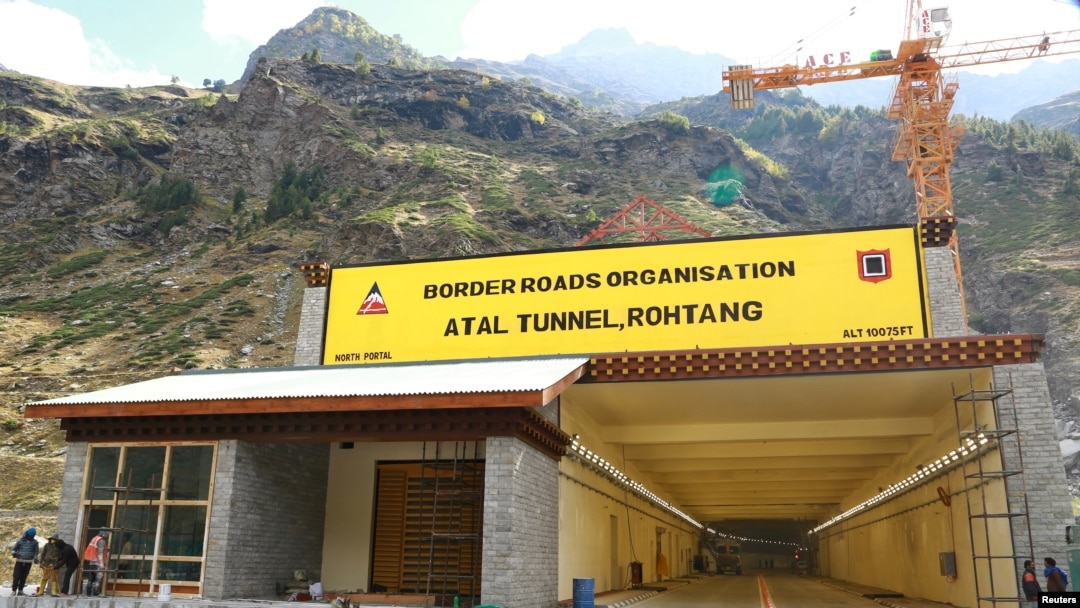After a decade of digging beneath the Himalayas at more than 3,000 meters, India has opened a strategic, nearly 9-kilometer long tunnel that will bypass a snowbound mountain pass in winter and cut the journey by 46 kilometers to Ladakh, where Indian and Chinese forces are confronting each other.
Your browser doesn’t support HTML5
India Races to Build Border Roads as Standoff With China Continues
The Atal tunnel will enable India to rapidly deploy troops and equipment to Ladakh. Straddling the India-China border, the cold desert of Ladakh in northern India has emerged as a flashpoint while both countries spar over their disputed frontier.
"Taking care of the needs of those who protect our country is one of the main priorities of this government," Indian Prime Minister Narendra Modi said while inaugurating the tunnel Saturday.
The world’s longest high-altitude tunnel is part of a network of roads India is racing to build in challenging mountainous terrain to improve connectivity to its Himalayan border with China, large stretches of which are still disputed.
The rapid construction of border infrastructure, according to analysts, is also one of the reasons increasing tensions with Beijing as the most serious military confrontation in decades between the Asian rivals drags into its sixth month.
While many of the projects like the Atal tunnel took years to complete, India is now redoubling efforts to expedite other border roads, bridges and high-altitude airstrips.
Its challenge is to try and close the gap with China’s network of roads and helipads on its side of the border and gain all year round access to remote areas like Ladakh, where military supplies have to be airlifted in winter months when heavy snow buries key roads.
"We have put our entire energy in developing our border infrastructure. The country hasn't seen roads, bridges and tunnels built at this scale," Modi said at the ceremony to open the tunnel.
Experts have long urged India to ramp up its border infrastructure, pointing out the critical role that fast movement of troops and military hardware can play in case of a full-scale conflict. Since the two countries fought a brief war in 1962, they have had several face-offs along their border.
“The Sino Indian military balance has always been tilting by and large in favor of China, and if we have to tilt that balance, one of the parameters is to get our infrastructure right,” points out Rajeswari Pillai Rajagopalan, Distinguished Fellow at the Observer Research Foundation in New Delhi. “Otherwise we won’t be able to get our forces and equipment to the border for a quick reaction. On the other hand, China can sustain its troops for a long period.”
About 250 kilometers west of the area where Indian and Chinese troops stand in close proximity in Ladakh, engineers are blasting a mountainside and drilling through rock near Chilling hamlet to expedite work on another road that will give crucial access to the Himalayan desert in winter – it is expected to be completed in three years. Indian officials say the target is to complete more than 60 key roads by 2022.
Last year India opened another key road, the Darbuk-Shyok-Daulat Beg Oldi road that winds through mountain passes connecting to a strategic airstrip at about 5,000 meters, close to the Chinese border in Ladakh.
FILE - An Indian army convoy moves on the Srinagar-Ladakh highway at Gagangeer, northeast of Srinagar, Indian-controlled Kashmir, Sept. 9, 2020.
While India and China’s differing perceptions of the disputed border lie at the heart of their tensions, Beijing has also objected to New Delhi’s rapid construction in the Himalayas.
"China does not recognize the so-called central territory of Ladakh illegally established by India. We also oppose the construction of infrastructure for the purpose of military control in the disputed border areas," Wang Wenbin, Chinese foreign ministry spokesman, said days before the Indian prime minister opened the new tunnel.
India points out, however, that the construction is taking place on its side of the border. Defense Minister Rajnath Singh stated in parliament last month that New Delhi is doubling spending on infrastructure along the India-China border and pointed out that Beijing has been building up its infrastructure in the remote mountains for decades.
The current standoff has underlined India’s vulnerabilities — months of military and diplomatic negotiations have not yet led to an agreement on disengaging forces with neither side backing down. While talks are continuing, troops who usually withdraw as the cold weather sets in, are preparing to dig in through the winter along the border.
“I don’t think India is left with a lot of different choices, so we have been strengthening our winter deployment,” says Rajagopalan pointing out that there is growing concern over a more “assertive and aggressive” China, whether it is in the South China Sea or the Himalayas.
To equip troops posted at dizzying heights in Ladakh, India has undertaken one of its largest military logistics exercises in recent years to stock supplies ahead of winter — large transport aircraft have helped haul in food, tents, heaters, winter clothing and shoes, in addition to ammunition.
“Indian troops are extremely well-conditioned to mountain warfare,” says retired Brigadier Rakesh Dhir, who is a former head of the High Altitude Warfare School in Indian Kashmir, which trains soldiers for combat on high mountain peaks where subzero temperatures and low levels of oxygen pose massive challenges. “It’s the accommodation, high altitude clothing and supplies, which are critical at those heights. If they reach, Indian troops will face absolutely no problem” according to Dhir.
That is what India hopes to achieve as it ramps up its infrastructure to the border. While some, like the Atal tunnel have opened, it will still take time to complete other mountain roads and bridges. But India hopes they will dramatically improve its ability to protect a disputed frontier that has turned volatile.


